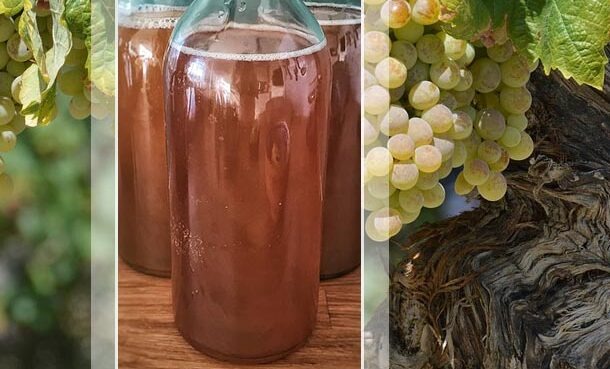Badagi – The Sweet Remedy of the Vine

“Before wine finds its strength, it passes through sweetness – that is badagi.”
In the heart of Georgia — a land where vines grow like wild poetry and every family has a winemaking story — there exists a little-known but deeply cherished drink: badagi. Not quite wine, not just juice, badagi is the sweet, softly fermenting essence of the grape, caught in a fleeting moment between innocence and maturity.
In Georgian villages, badagi has long been more than a delicious seasonal drink — it has been a symbol of vitality, a folk remedy, and a spiritual bridge between nature and nourishment. With its rich flavor, natural fizz, and hidden healing powers, badagi has been passed down in pitchers and clay cups through generations, accompanied by proverbs, rituals, and care.
🍇 What Exactly Is Badagi?
Badagi is made from freshly pressed grape juice that has just begun to ferment — usually between the 3rd and 7th day after the harvest. It is lightly alcoholic (1–3%), fizzy, and sweet with a tang of fermentation. At this stage, it still retains the grape’s original sugars and nutritional value, but begins to develop some of the depth found in wine.
In traditional Georgian winemaking, badagi is not a separate product, but a natural stage in the transformation of grape juice into wine. However, in folk tradition, this in-between phase took on a life of its own — eagerly awaited, carefully tasted, and consumed not just for pleasure, but for its perceived health benefits.
🌿 Folk Medicine and the Power of Badagi
For centuries, badagi has held an honored place in folk medicine, especially in the mountainous and rural regions of Georgia. It was considered a gentle, nourishing remedy that could support the body during seasonal changes, illness, and physical exhaustion.
Let’s explore the most widely recognized traditional uses of badagi:
1. A Natural Energy Booster
Badagi was often given to children, the elderly, and those recovering from illness or hard physical labor. Its natural sugars — mainly glucose and fructose — are easily digestible, providing quick energy without straining the digestive system.
Villagers believed badagi could “revive the blood” and “wake up the body.” Field workers drank it during grape harvest, and children were offered a small glass in the morning before heading to school or chores.
2. Liver Cleanser and Digestive Aid
In Georgian folk medicine, the liver was seen as the body’s filter, and keeping it healthy was essential. Badagi, with its mild acidity and early-stage fermentation, was believed to stimulate the liver and help the body process heavy or fatty foods.
After large feasts — especially during autumn celebrations — people would sip badagi as a post-meal tonic. The phrase often used was:
“Badagi warms the belly and opens the appetite.”
Its natural yeasts and enzymes were thought to help with sluggish digestion and bloating.
3. Blood Strengthener
Women, especially after childbirth, were given badagi to rebuild strength and “sweeten the blood.” The grape’s iron content, along with antioxidants and B vitamins, made it a natural remedy for fatigue, dizziness, and pale complexion.
Although no blood tests were available, villagers would judge the effects by improved skin color, appetite, and energy. Folk healers (often elderly women) would prescribe badagi as a part of home recovery routines.
4. Immune Support and Fever Relief
Chilled badagi was traditionally given to people with low-grade fevers or colds. Its refreshing, slightly sour taste helped reduce internal heat and encourage sweating. Combined with herbs or warm water, badagi was part of natural fever-lowering strategies before pharmaceuticals became common.
Parents would sometimes mix it with mint or lemon balm tea and offer it to sick children in small amounts.
5. Nervous System Calmer
While it contains only a small amount of alcohol, the gentle calming effect of badagi was appreciated by those suffering from sleeplessness, anxiety, or physical tension. A small glass before bed — often with a crust of bread or dried fruit — was said to “soften the nerves” and help the mind rest.
In some villages, badagi was also used in rituals around the full moon to calm children who experienced nightmares or “night restlessness,” blending healing with spiritual belief.
🍂 Cultural Significance and Ritual Use
Badagi’s importance went beyond the medical. It was part of seasonal rituals, community gatherings, and family traditions. Its short-lived nature — just a few days before turning fully alcoholic — gave it a special urgency and joy.
During Rtveli (the grape harvest festival), families would taste the first badagi with reverence, often offering a sip to the ancestors by pouring a drop on the earth.
Children were told, “Drink this now, or it will turn to wine!” — creating excitement and a sense of rare occasion.
Elders believed that the quality of badagi predicted the strength of the coming wine.
It was also a key ingredient in making churchkhela — Georgia’s famous string of nuts dipped in thickened grape juice. The juice used was often partially fermented badagi, giving the final product a richer, more complex flavor.
⚠️ Warnings from the Wise
While badagi was considered beneficial, it was also treated with respect. Folk wisdom warned that overdrinking could upset the balance of the body — especially in young children or pregnant women.
“Too much sweetness leads to sourness,” they’d say — a reminder that even nature’s remedies need moderation.
🍷 More Than a Drink
Badagi represents a moment of transformation, of transition, and of natural balance. In the rhythm of the vine’s life — from green sprout to golden harvest, from juice to wine — badagi is the pause, the breath, the sweetness before strength.
In modern times, where synthetic supplements and processed drinks dominate, badagi offers a reminder:
sometimes, the most healing things are simple, seasonal, and made by nature itself.
So the next time you sip badagi — if you’re lucky enough to find some — remember, you’re not just drinking a grape drink.
You’re tasting a living tradition, a folk medicine, and a vine’s sweet whisper before it becomes wine.
✍️ Written in the spirit of Georgian folk wisdom and with gratitude to the grandmothers, winemakers, and healers who kept these traditions alive.












